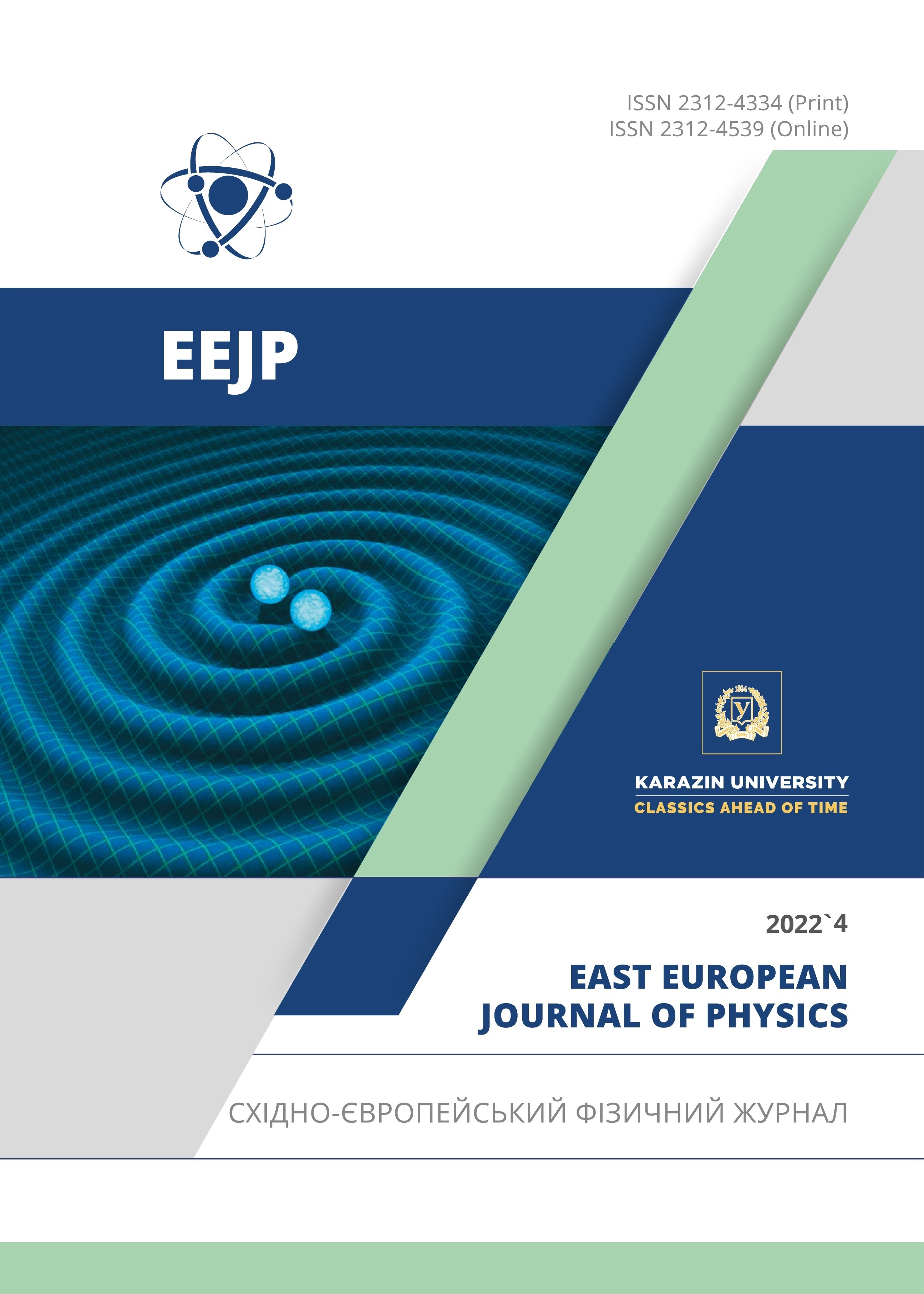Heavy-Light Meson Masses in the Framework of Trigonometric Rosen-Morse Potential Using the Generalized Fractional Derivative
Abstract
Trigonometric Rosen-Morse Potential is employed as a mesonic potential interaction. The extended Nikiforov-Uvarov method is used to solve the N-radial Fractional Schrödinger equation analytically. Using the generalized fractional derivative, the energy eigenvalues are obtained in fractional forms. The current findings are used to calculate the masses of mesons such as charmonium, bottomonium, and heavy-light mesons. The current findings are superior to those of other recent studies and show good agreement with experimental data as a result, the fractional parameter is crucial in optimizing meson masses.
Downloads
References
M. Abu-shady, and Rashdan, Phys. Rev. C, 81, 015203 (2010). https://doi.org/10.1103/PhysRevC.81.015203
M. Abu-shady, and H.M. Mansour, Phys. Rev. C, 85, 055204 (2012). https://doi.org/10.1103/PhysRevC.85.055204
M. Rashdan, M. Abu-Shady, and T.S.T. Ali, Int. Mod. Phys. A, 22, 2673 (2007). https://doi.org/10.1142/S0217751X07036178
M. Rashdan, M. Abu-Shady, and T.S.T. Ali, Int. Mod. Phys. E, 15, 143 (2006). https://doi.org/10.1142/S0218301306003965
E.P. Inyang, E.O. Obisung, E.S. William, and I.B. Okon. East European Journal of Physics, 3, 104 (2022). https://doi.org/10.26565/2312-4334-2022-3-14
M. Abu-Shady, and S.Y. Ezz-Alarb, Few-body systems, 60, 66 (2019). https://doi.org/10.1007/s00601-019-1531-y
M. Abu-Shady, T.A. Abdel-Karim, and E.M. Khokha, Advances in High Energy Physics, 2018, 7356843 (2018). https://doi.org/10.1155/2018/7356843
M. Abu-Shady, and E.M. Khokha, Advances in High Energy Physics, 7032041 (2018). https://doi.org/10.1155/2018/7032041
E. Omugbe, O.E. Osafile, I.B. Okon, E.P. Inyang, E.S. William, and A. Jahanshir, Few-Body systems, 63, 7 (2022). https://doi.org/10.1007/s00601-021-01705-1
E.P. Inyang, E.P. Inyang, E.S. William, and E.E. Ibekwe, Jordan Journal of Physics, 14, 339 (2021). https://doi.org/10.47011/14.4.8
Al-Jamel, Int. J. Mod. Phys. A, 34, 1950054 (2019). https://doi.org/10.1142/S0217751X19500544
E.P. Inyang, and E.O. Obisung, East European Journal of Physics, 3, 38 (2022). https://doi.org/10.26565/2312-4334-2022-3-04
H. Karayer, D. Demirhan, and F. Büyükk, Commun. Theor. Phys. 66, 12 (2018). https://doi.org/10.1088/0253-6102/66/1/012
C.O. Edet, S. Mahmoud, E.P. Inyang, N. Ali, S.A. Aljunid, R. Endut, A.N. Ikot, and M. Asjad, Mathematics, 10(15), 2824 (2022). https://doi.org/10.3390/math10152824
E.P. Inyang, E.S. William, J.E. Ntibi, J.A. Obu, P.C. Iwuji, and E.P. Inyang. Canadian Journal of Physics, 100(10), 463 (2022). https://doi.org/10.1139/cjp-2022-0030
E.E. Ibekwe, U.S. Okorie, J.B. Emah, E.P. Inyang, and S.A. Ekong, Eur. Phys. J. Plus, 136, 87 (2021). https://doi.org/10.1140/epjp/s13360-021-01090-y
C.B.C. Jasso, and M. Kirchbach, AIP Conf. Proc. 857, 275 (2006). https://doi.org/10.1063/1.2359266
C.B.C. Jasso, and M. Kirchbach, J. Phys. A: Math. Gen. 39, 547 (2006).
U.A. Deta, Suparmi, Cari, A.S. Husein, H. Yulian, I.K.A. Khaled, H. Luqman, and Supriyanto, 4th. Inter. Conf. Adv. Nucl. Sci. Eng. 1615, 121-127 (2014). https://doi.org/10.1063/1.4895872
M. Abu-Shady, Inter. J. Mod. Phys. A, 34(31), 1950201 (2019). https://doi.org/10.1142/S0217751X19502014
M. Abu-Shady, and M.K.A. Kaabar, Mathematical Problems in Engineering, 2021, 9444803 (2021). https://doi.org/10.1155/2021/9444803
S. Sharma, Hindawi. Pub. Corp, 2013, 452978, (2013). https://doi.org/10.1155/2013/452978
E.P. Inyang, E.P. Inyang, I.O. Akpan, J.E. Ntibi, and E.S. William, Canadian Journal Physics, 99, 990 (2021). https://doi.org/10.1139/cjp-2020-0578
E.P. Inyang, P.C. Iwuji, J.E. Ntibi, E. Omugbe, E.A. Ibanga and E.S. William, East European Journal of Physics, 2, (2022) 51. https://doi.org/10.26565/2312-4334-2022-2-05
R. Kumar, and F. Chand, Commun. Theor. Phys. 59, 528 (2013). https://doi.org/10.1088/0253-6102/59/5/02
N.V. Masksimenko, and S.M. Kuchin, Russ. Phys. J. 54, 57 (2011).
R. Kumar, and F. Chand, Phys. Scr. 85, 055008 (2012). https://doi.org/10.1088/0031-8949/85/05/055008
A.K. Ray, and P.C. Vinodkumar, Pramana J. Phys. 66, 953 (2006). https://doi.org/10.1007/BF02704795
E.J. Eichten, and C. Quigg, Phys. Rev. D, 49, 5845 (1994). https://doi.org/10.1103/PhysRevD.49.5845
D. Ebert, R.N. Faustov, and V.O. Galkin, Phys. Rev. D, 67, 014027 (2003). https://doi.org/10.1103/PhysRevD.67.014027
M. Tanabashi, et al, (Particle Data Group), "Review of Particle Physics". Physical Review D, 98(3), 030001 (2018). https://doi.org/10.1103/PhysRevD.98.030001
C. Patrignani, et al, (Particle data group), Chinese Physics C, 40, 100001 (2016). https://doi.org/10.1088/1674-1137/40/10/100001
M. Abu-Shady, M.K.A. Kaabar, Computational and Mathematical Methods in Medicine, 2022, 2138775, (2022). https://doi.org/10.1155/2022/2138775
Copyright (c) 2022 Mohamed Abu-Shady, Etido P. Inyang

This work is licensed under a Creative Commons Attribution 4.0 International License.
Authors who publish with this journal agree to the following terms:
- Authors retain copyright and grant the journal right of first publication with the work simultaneously licensed under a Creative Commons Attribution License that allows others to share the work with an acknowledgment of the work's authorship and initial publication in this journal.
- Authors are able to enter into separate, additional contractual arrangements for the non-exclusive distribution of the journal's published version of the work (e.g., post it to an institutional repository or publish it in a book), with an acknowledgment of its initial publication in this journal.
- Authors are permitted and encouraged to post their work online (e.g., in institutional repositories or on their website) prior to and during the submission process, as it can lead to productive exchanges, as well as earlier and greater citation of published work (See The Effect of Open Access).








